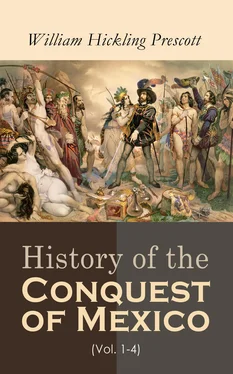In this state of things, it was beneficently ordered by Providence that the land should be delivered over to another race, who would rescue it from the brutish superstitions that daily extended wider and wider with extent of empire. [142]The debasing institutions of the Aztecs furnish the best apology for their conquest. It is true, the conquerors brought along with them the Inquisition. But they also brought Christianity, whose benign radiance would still survive when the fierce flames of fanaticism should be extinguished; dispelling those dark forms of horror which had so long brooded over the fair region of Anahuac.
The most important authority in the preceding chapter, and, indeed, wherever the Aztec religion is concerned, is Bernardino de Sahagun, a Franciscan friar, contemporary with the Conquest. His great work, Historia universal de Nueva-España , has been recently printed for the first time. The circumstances attending its compilation and subsequent fate form one of the most remarkable passages in literary history.
Sahagun was born in a place of the same name, in old Spain. He was educated at Salamanca, and, having taken the vows of St. Francis, came over as a missionary to Mexico in the year 1529. Here he distinguished himself by his zeal, the purity of his life, and his unwearied exertions to spread the great truths of religion among the natives. He was the guardian of several conventual houses, successively, until he relinquished these cares, that he might devote himself more unreservedly to the business of preaching, and of compiling various works designed to illustrate the antiquities of the Aztecs. For these literary labors he found some facilities in the situation which he continued to occupy, of reader, or lecturer, in the College of Santa Cruz, in the capital.
The “Universal History” was concocted in a singular manner. In order to secure to it the greatest possible authority, he passed some years in a Tezcucan town, where he conferred daily with a number of respectable natives unacquainted with Castilian. He propounded to them queries, which they, after deliberation, answered in their usual method of writing, by hieroglyphical paintings. These he submitted to other natives, who had been educated under his own eye in the College of Santa Cruz; and the latter, after a consultation among themselves, gave a written version, in the Mexican tongue, of the hieroglyphics. This process he repeated in another place, in some part of Mexico, and subjected the whole to a still further revision by a third body in another quarter. He finally arranged the combined results into a regular history, in the form it now bears; composing it in the Mexican language, which he could both write and speak with great accuracy and elegance,—greater, indeed, than any Spaniard of the time.
The work presented a mass of curious information, that attracted much attention among his brethren. But they feared its influence in keeping alive in the natives a too vivid reminiscence of the very superstitions which it was the great object of the Christian clergy to eradicate. Sahagun had views more liberal than those of his order, whose blind zeal would willingly have annihilated every monument of art and human ingenuity which had not been produced under the influence of Christianity. They refused to allow him the necessary aid to transcribe his papers, which he had been so many years in preparing, under the pretext that the expense was too great for their order to incur. This occasioned a further delay of several years. What was worse, his provincial got possession of his manuscripts, which were soon scattered among the different religious houses in the country.
In this forlorn state of his affairs, Sahagun drew up a brief statement of the nature and contents of his work, and forwarded it to Madrid. It fell into the hands of Don Juan de Ovando, president of the Council for the Indies, who was so much interested in it that he ordered the manuscripts to be restored to their author, with the request that he would at once set about translating them into Castilian. This was accordingly done. His papers were recovered, though not without the menace of ecclesiastical censures; and the octogenarian author began the work of translation from the Mexican, in which they had been originally written by him thirty years before. He had the satisfaction to complete the task, arranging the Spanish version in a parallel column with the original, and adding a vocabulary, explaining the difficult Aztec terms and phrases; while the text was supported by the numerous paintings on which it was founded. In this form, making two bulky volumes in folio, it was sent to Madrid. There seemed now to be no further reason for postponing its publication, the importance of which could not be doubted. But from this moment it disappears; and we hear nothing further of it, for more than two centuries, except only as a valuable work, which had once existed and was probably buried in some one of the numerous cemeteries of learning in which Spain abounds.
At length, towards the close of the last century, the indefatigable Muñoz succeeded in disinterring the long-lost manuscript from the place tradition had assigned to it,—the library of a convent at Tolosa, in Navarre, the northern extremity of Spain. With his usual ardor, he transcribed the whole work with his own hands, and added it to the inestimable collection, of which, alas! he was destined not to reap the full benefit himself. From this transcript Lord Kingsborough was enabled to procure the copy which was published in 1830, in the sixth volume of his magnificent compilation. In it he expresses an honest satisfaction at being the first to give Sahagun’s works to the world. But in this supposition he was mistaken. The very year preceding, an edition of it, with annotations, appeared in Mexico, in three volumes octavo. It was prepared by Bustamante,—a scholar to whose editorial activity his country is largely indebted,—from a copy of the Muñoz manuscript which came into his possession. Thus this remarkable work, which was denied the honors of the press during the author’s lifetime, after passing into oblivion, reappeared, at the distance of nearly three centuries, not in his own country, but in foreign lands widely remote from each other, and that almost simultaneously. The story is extraordinary, though unhappily not so extraordinary in Spain as it would be elsewhere.
Sahagun divided his history into twelve books. The first eleven are occupied with the social institutions of Mexico, and the last with the Conquest. On the religion of the country he is particularly full. His great object evidently was, to give a clear view of its mythology, and of the burdensome ritual which belonged to it. Religion entered so intimately into the most private concerns and usages of the Aztecs, that Sahagun’s work must be a text-book for every student of their antiquities. Torquemada availed himself of a manuscript copy, which fell into his hands before it was sent to Spain, to enrich his own pages,—a circumstance more fortunate for his readers than for Sahagun’s reputation, whose work, now that it is published, loses much of the originality and interest which would otherwise attach to it. In one respect it is invaluable; as presenting a complete collection of the various forms of prayer, accommodated to every possible emergency, in use by the Mexicans. They are often clothed in dignified and beautiful language, showing that sublime speculative tenets are quite compatible with the most degrading practices of superstition. It is much to be regretted that we have not the eighteen hymns inserted by the author in his book, which would have particular interest, as the only specimen of devotional poetry preserved of the Aztecs. The hieroglyphical paintings, which accompanied the text, are also missing. If they have escaped the hands of fanaticism, both may reappear at some future day.
Читать дальше












